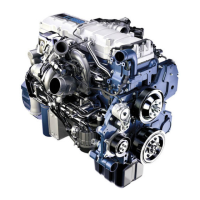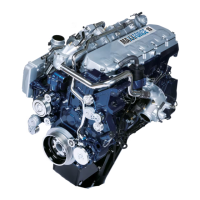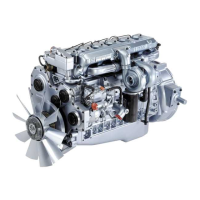44 ENGINE SYSTEMS
2. Signal conditioner
The signal conditioner in the internal microprocessor
converts analog signals to digital signals, squares up
sine wave signals, or amplifies low intensity signals to
a level that the ECM microprocessor can process.
3. Microprocessor
The ECM microprocessor stores operating
instructions (control strategies) and value tables
(calibration parameters). The ECM compares stored
instructions and values with conditioned input values
to determine the correct operating strategy for all
engine operations.
Continuous calculations in the ECM occur at
two different levels or speeds: Foreground and
Background.
• Foreground calculations are much faster than
background calculations and are normally more
critical for engine operation. Engine speed control
is an example.
• Background calculations are normally variables
that change at a slower rates. Engine
temperature is an example.
Diagnostic Trouble Codes (DTCs) are generated by
the microprocessor, if inputs or conditions do not
comply with expected values.
Diagnostic strategies are also programmed into the
ECM. Some strategies monitor inputs continuously
and command the necessary outputs to achieve the
correct performance of the engine.
Microprocessor memory
The ECM microprocessor includes Read Only
Memory (ROM) and Random Access Memory (RAM).
ROM
ROM stores permanent information for calibration
tables and operating strategies. Permanently stored
information cannot be changed or lost by turning the
ignition key OFF or when ECM power is interrupted.
ROM includes the following:
• Vehicle configuration, modes of operation, and
options
• Engine Family Rating Code (EFRC)
• Engine warning and protection modes
RAM
RAM stores temporary information for current engine
conditions. Temporary information in RAM is lost
when the ignition key is turned to OFF or when ECM
power is interrupted. RAM information includes the
following:
• Engine temperature
• Engine rpm
• Accelerator pedal position
4. Actuato r control
The ECM controls the actuators by applying a low
level signal (low side driver) or a high level signal (high
side driver). When switched on, both drivers complete
a ground or power circuit to an actuator.
Actuators are controlled in three ways, determined by
thekindofactuator.
• A duty cycle (percent time on/off)
• A controlled pulse width
•Switchedonoroff
ECM Control of Engine Operation
The ECM controls engine operation with the following:
• Variable Geometry Turbocharger (VGT) control
module
• EGR control module and control valve
• Diamond Logic® engine brake
•IPRvalve
• Inlet Air Heater (IAH) assembly
Variable G e ometry Turbocharger (VGT) control
module
The VGT control module controls vane position in
the turbine housing. Vane position is controlled by
aswitchingvoltagesourceintheECM.Theground
circuit is supplied directly from the battery ground at
all times.
The actuator control is set by a pulse width modulated
signal in response to engine speed, desired fuel
quantity, boost or exhaust back pressure and altitude.
EGES-265-2
Read all safety instructions in the "Safety Information" section of this manual before doing any procedures.
Follow all warnings, cautions, and notes.
© 2009 Navistar, Inc.

